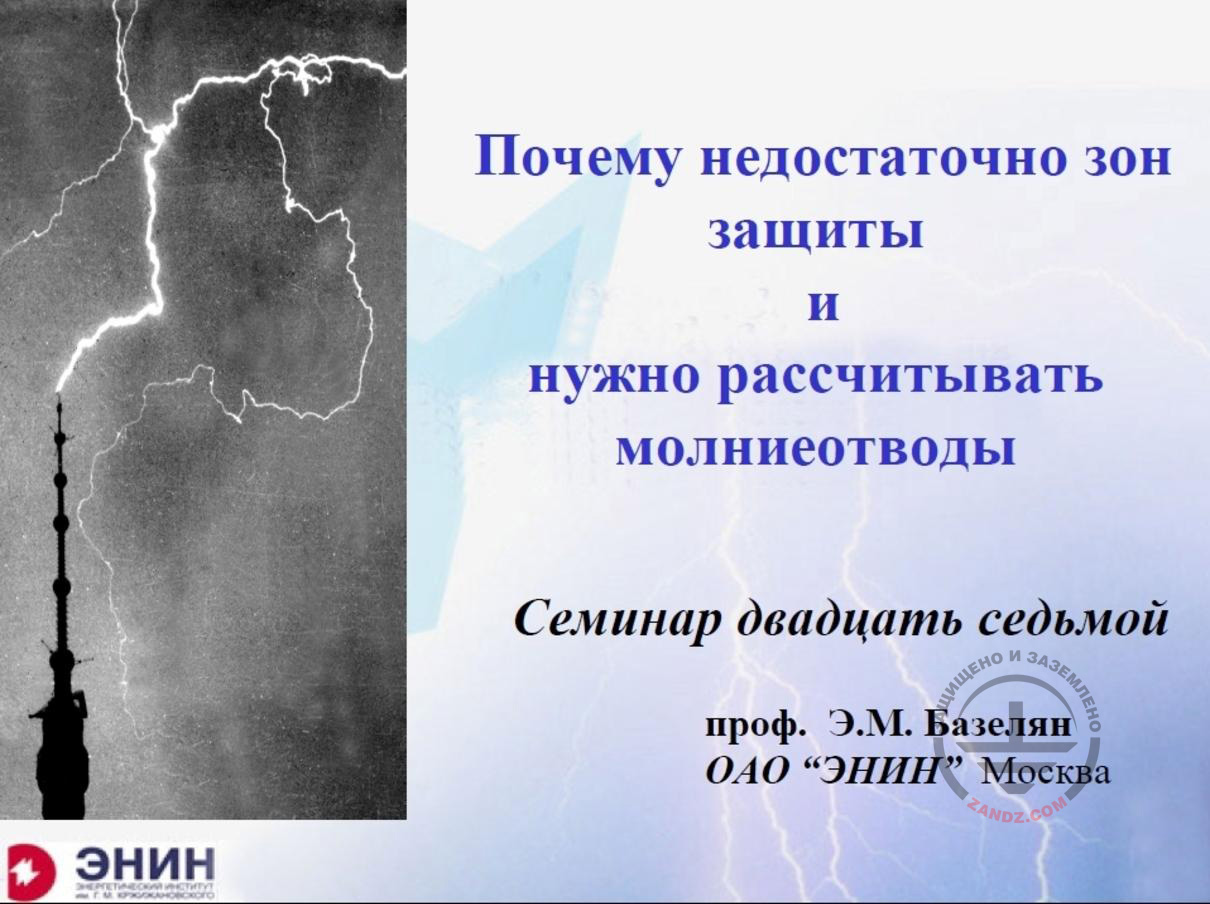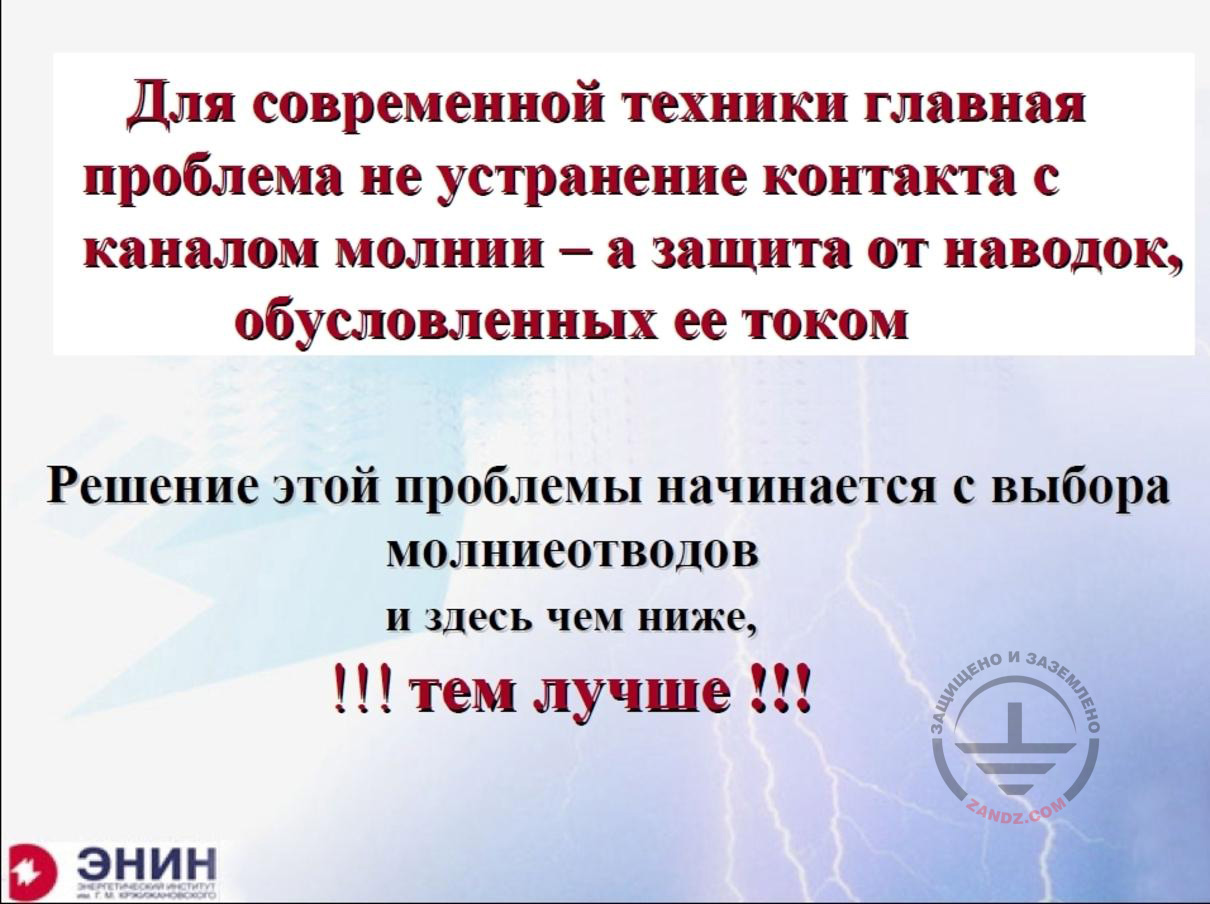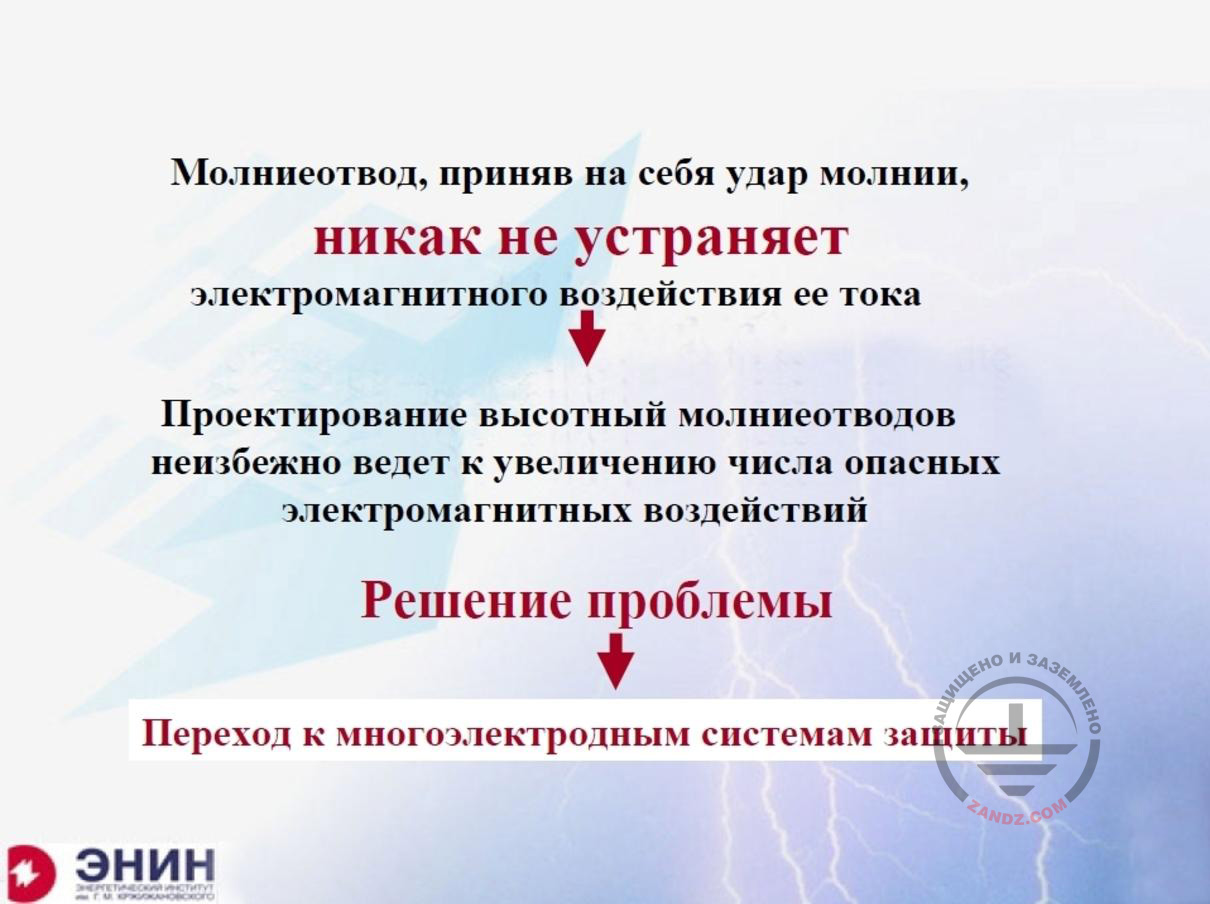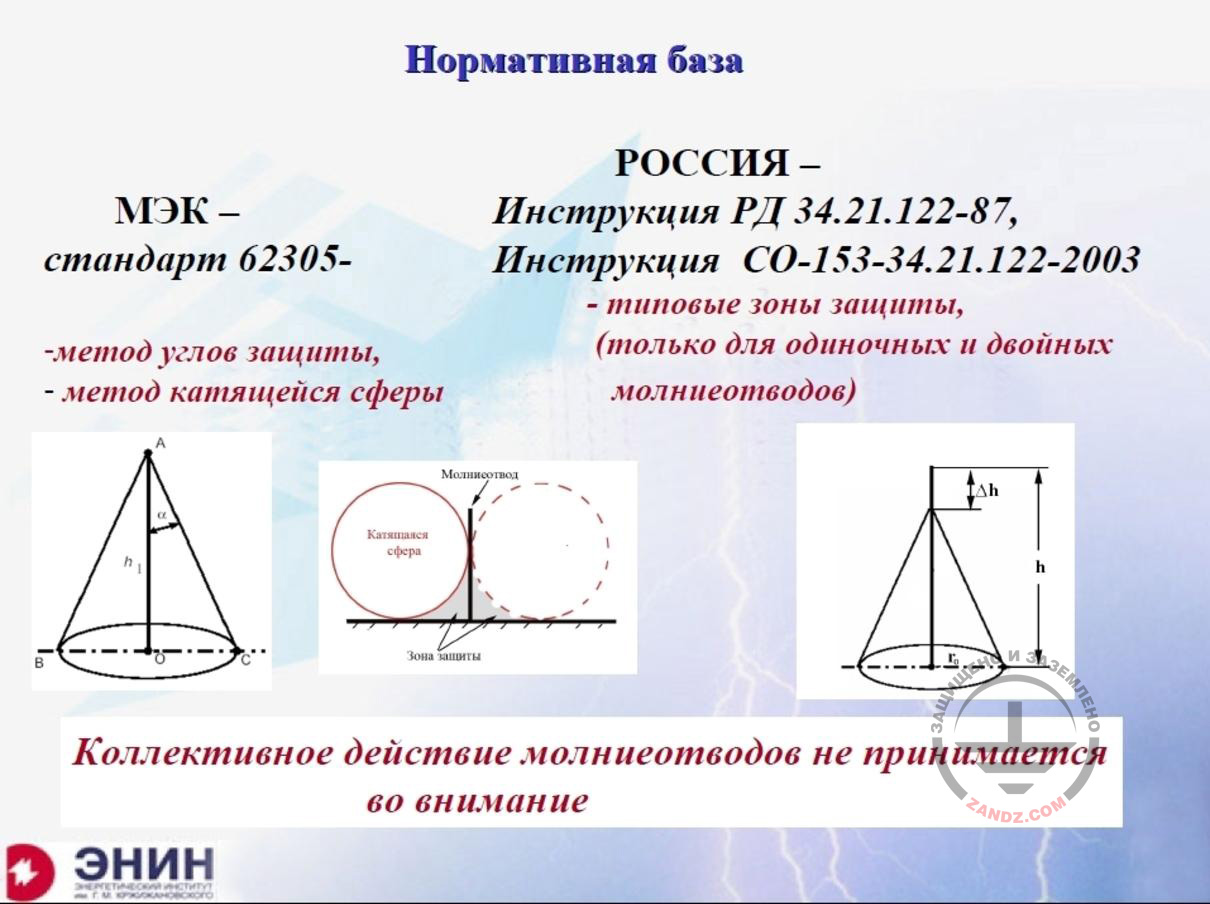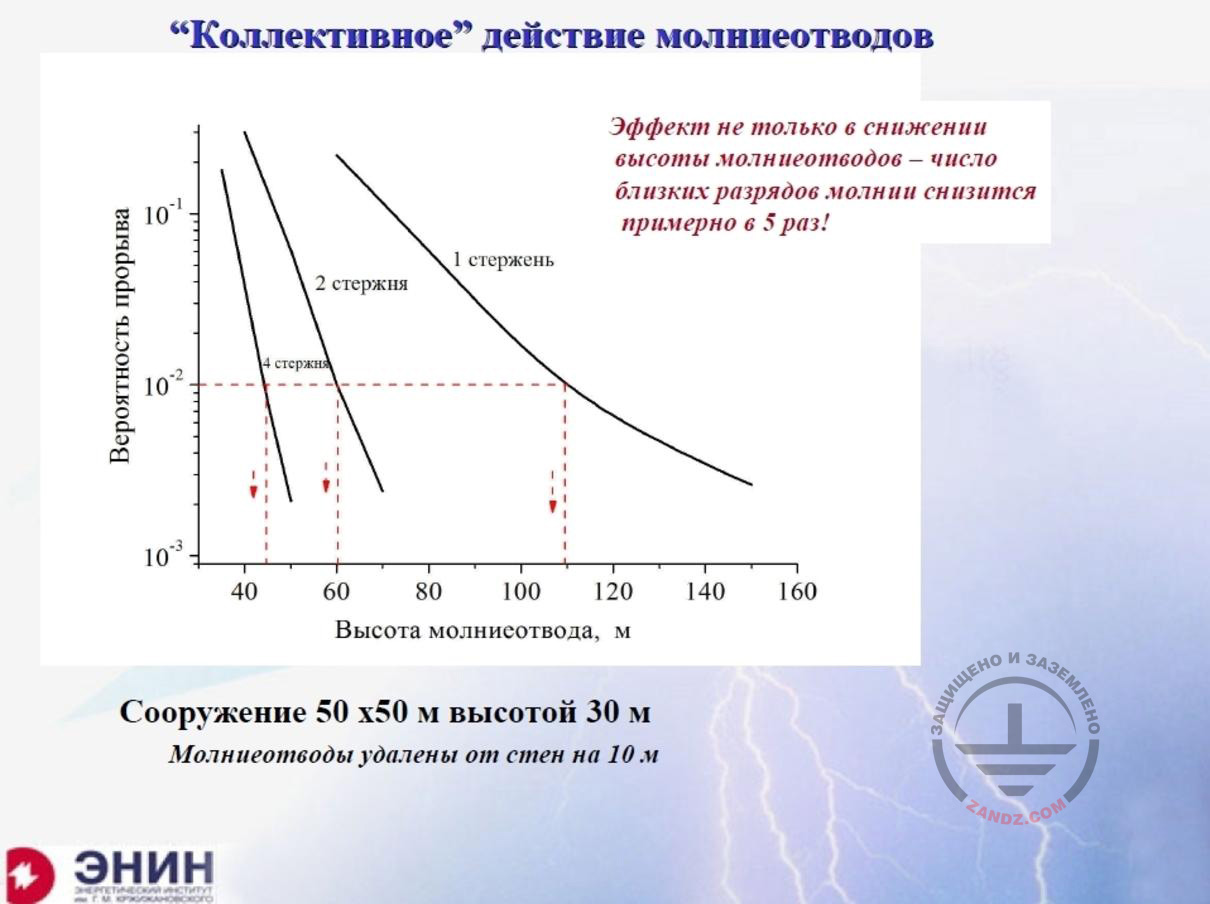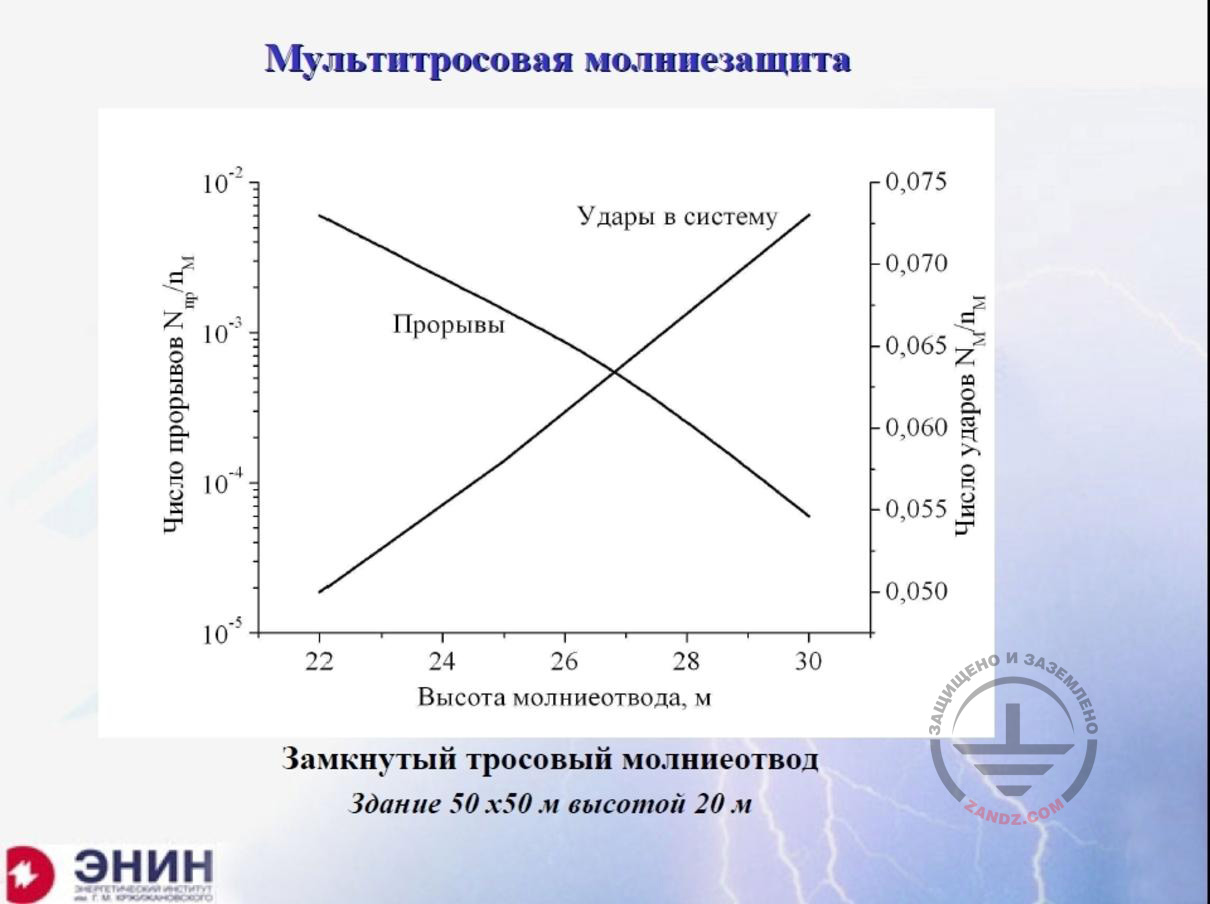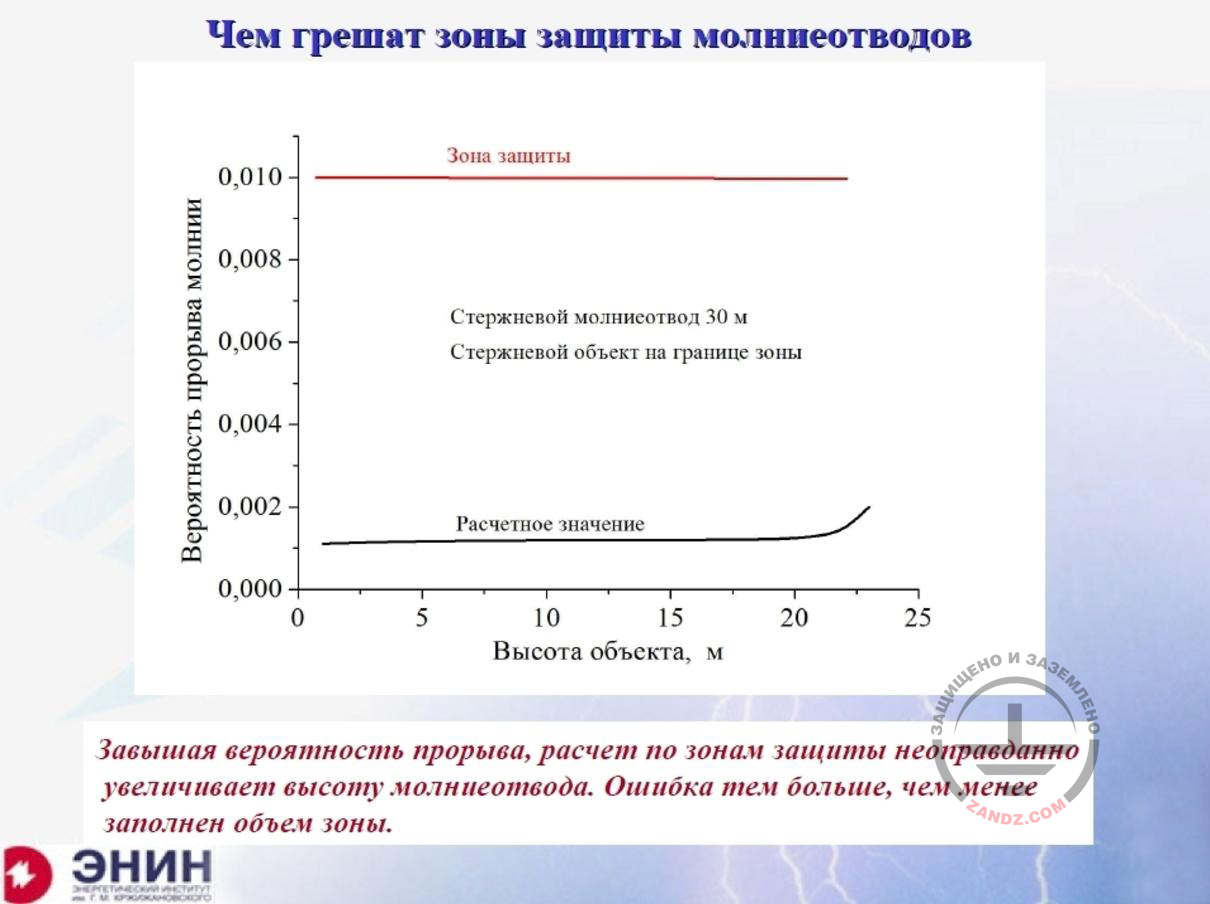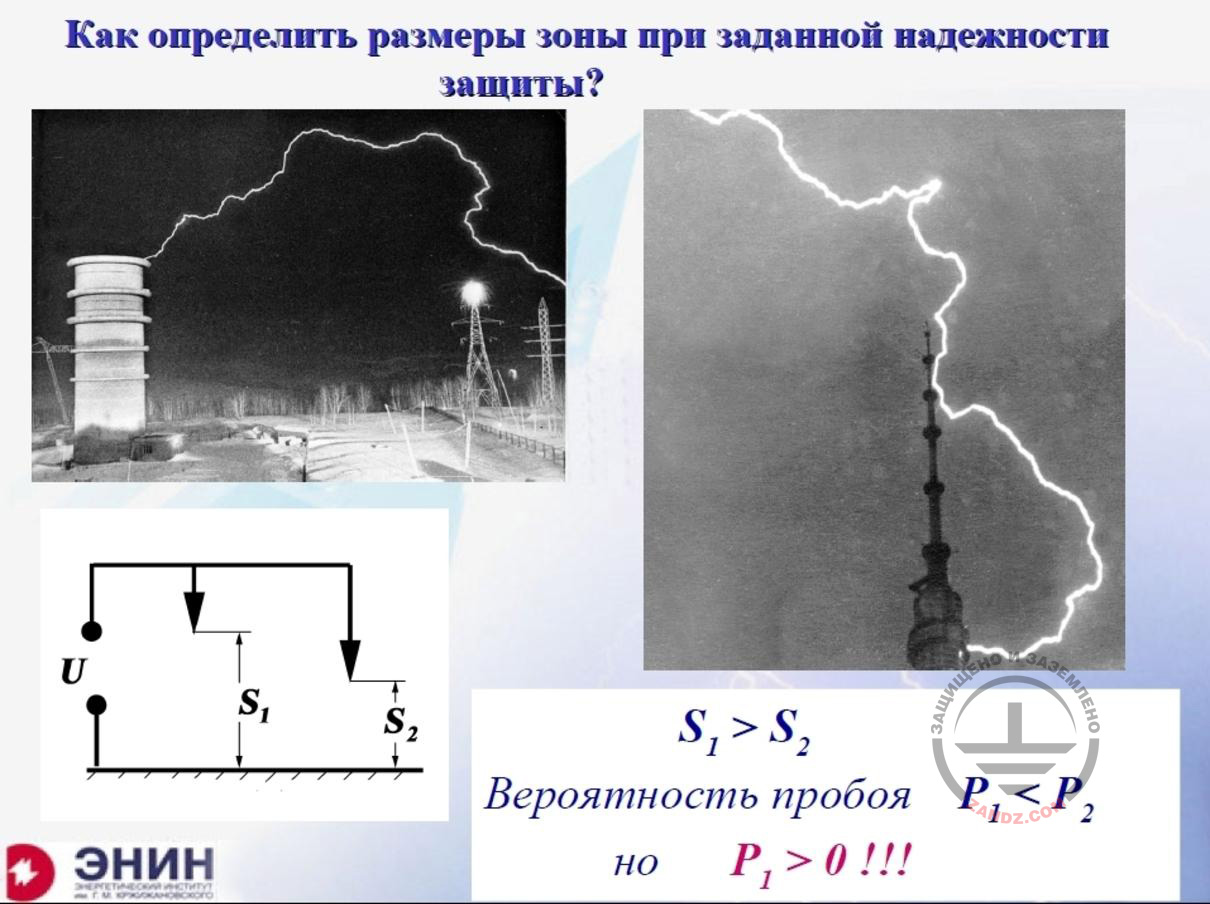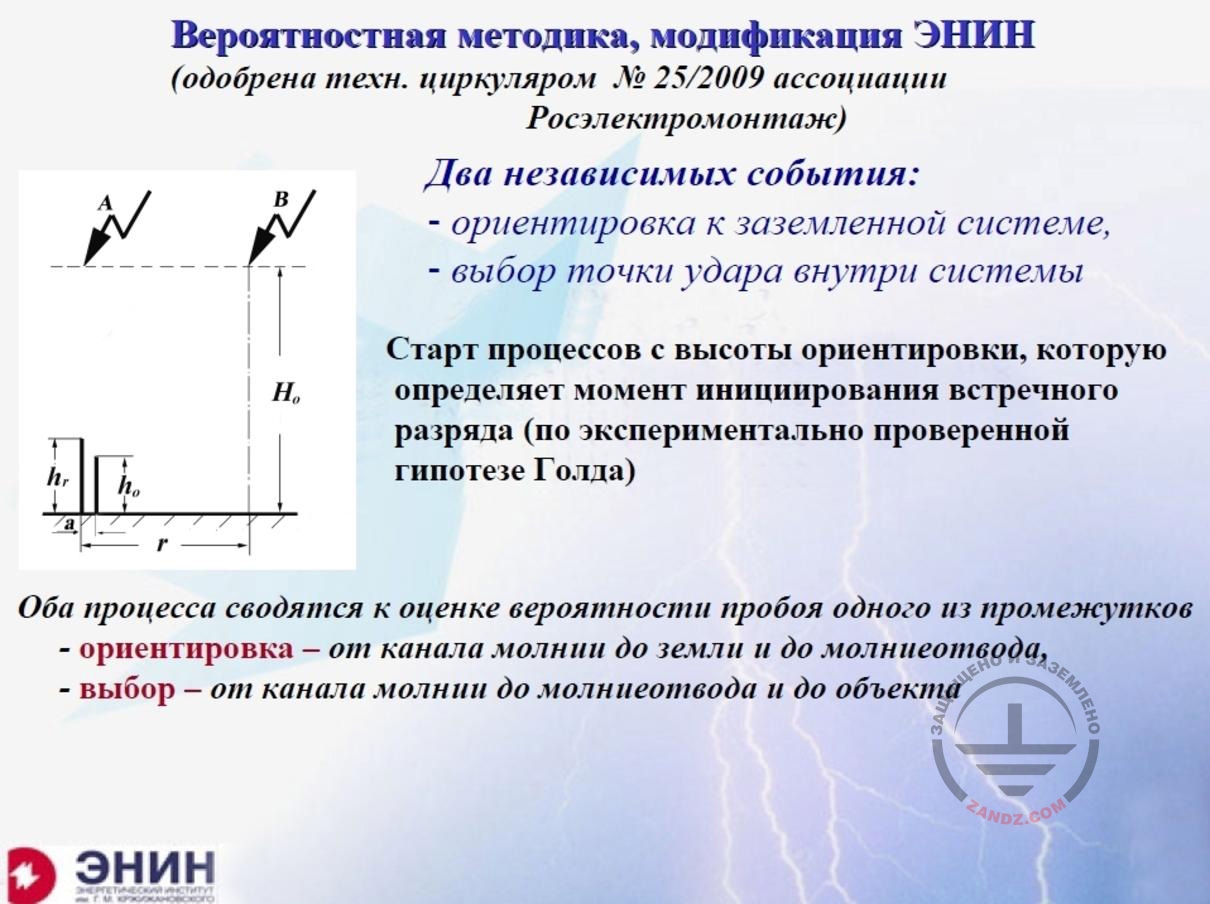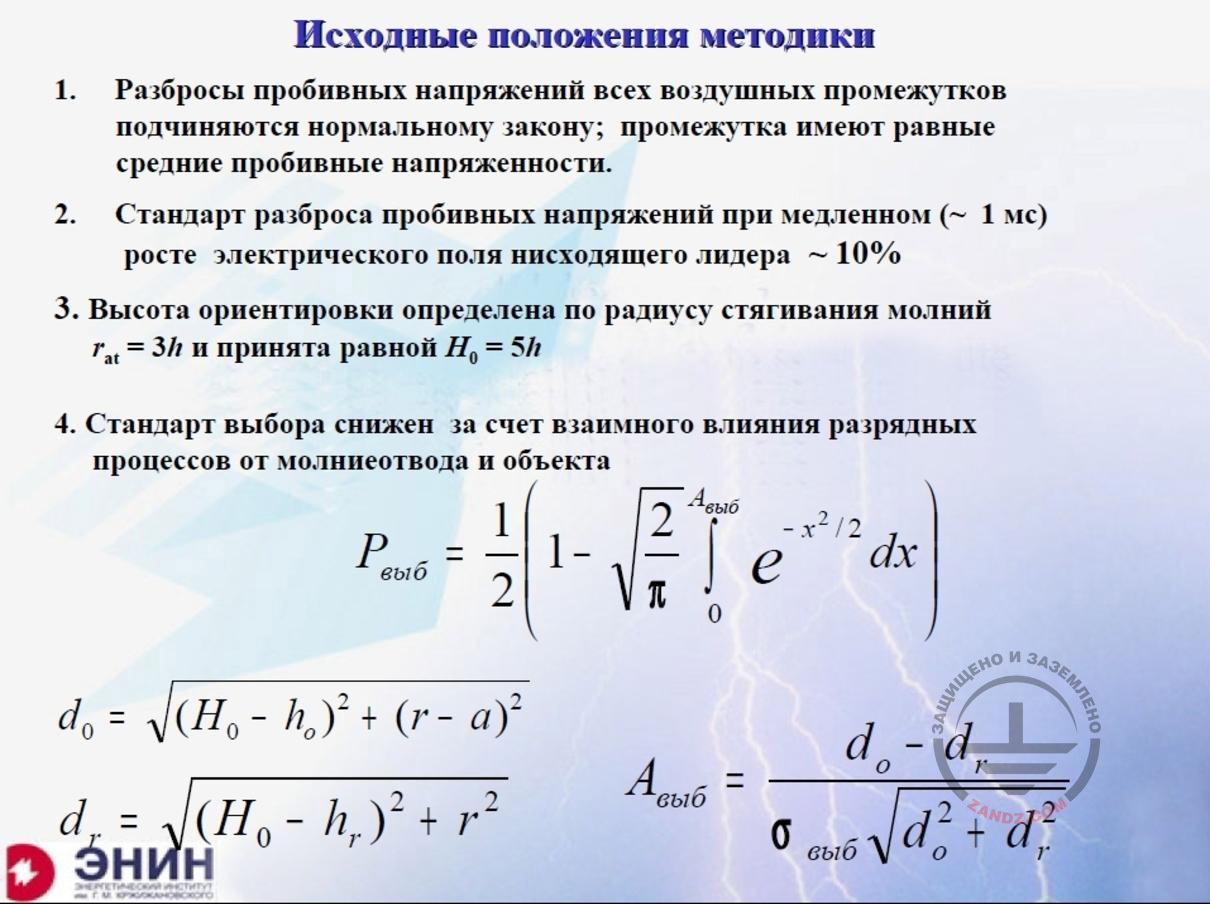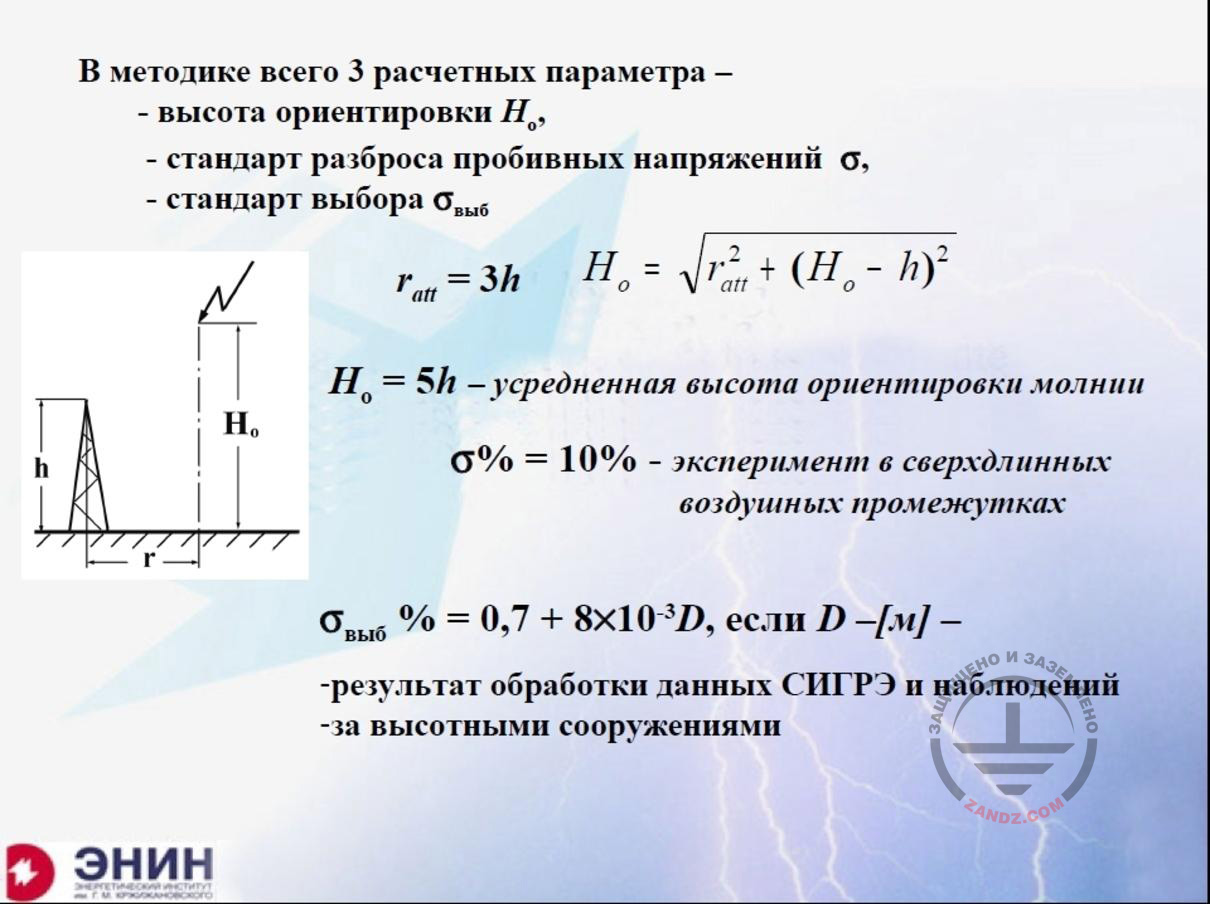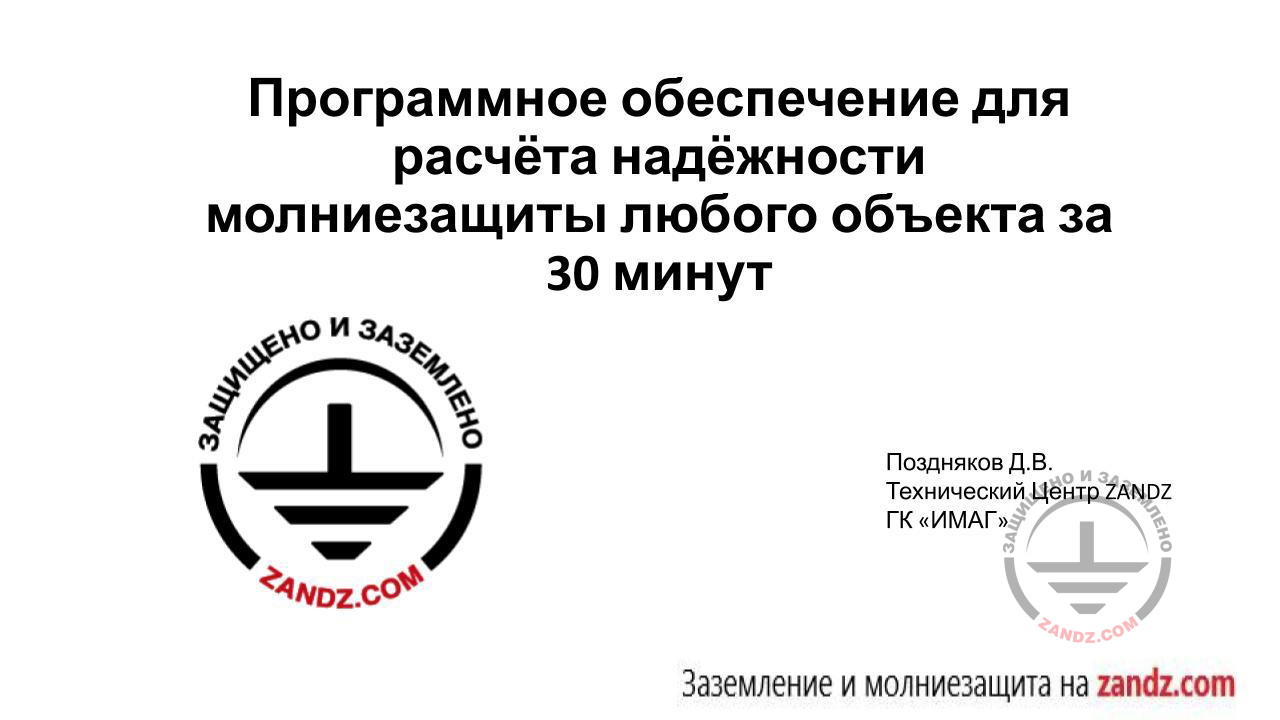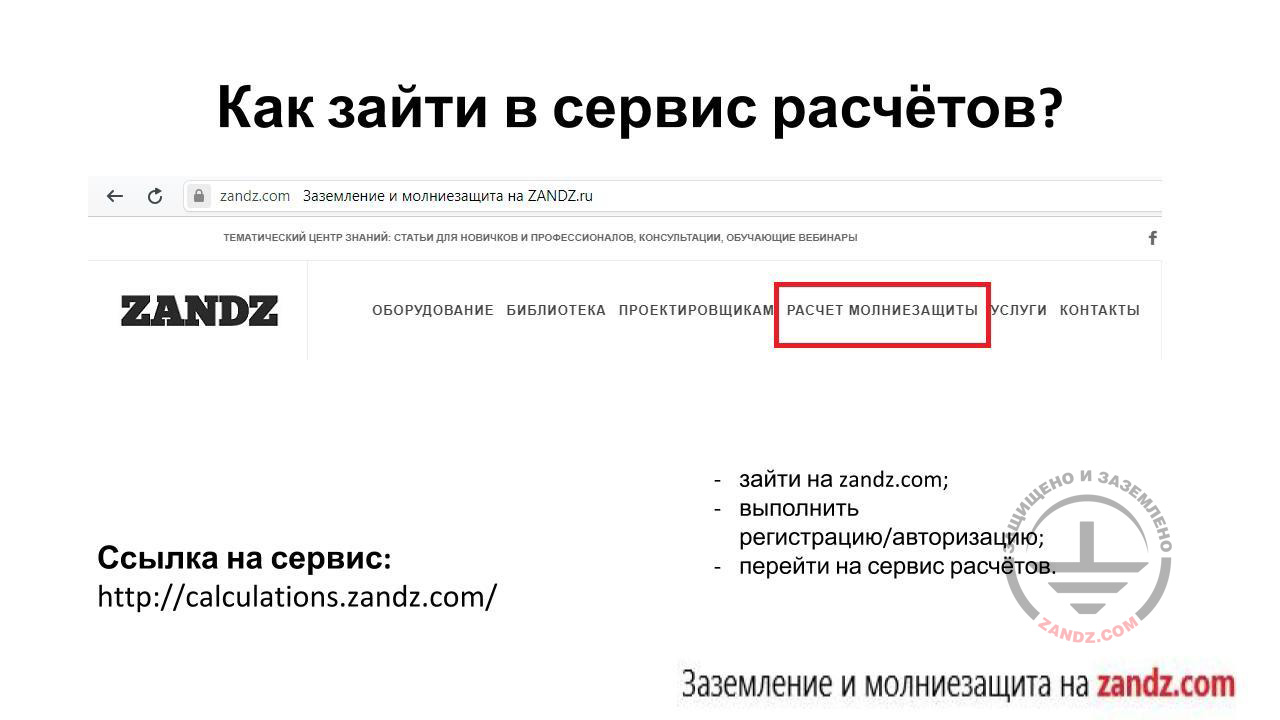(held on May 15, 2019 at 11:00)
The ZANDZ Project continues the educational course. On May 15, at 11:00 (Moscow time), we will hold a webinar dedicated to the software for calculating the lightning protection reliability.
In the first part of the webinar, Professor Eduard Meerovich Bazelyan will describe the software for calculating the lightning protection reliability in more details.
- The substantiation of the proposed calculation technique based on the long spark research that have demonstrated a large difference in paths and breakthrough voltages. And these facts are used in the statistical technique, even though they are simplified.
- The technique for reducing the lightning arrester height when using the multi-electrode systems without the protection zones.
- The need to provide protection against the direct lightning strikes using the lightning arresters that are as low as possible (this is associated with the electromagnetic compatibility issue).
- General provisions of the technique during its transition to the real-life objects. Major benefits and drawbacks.
In the second part of the webinar, Denis Pozdnyakov, the Technical Specialist for Earthing and Lightning Protection, will provide two versions of an example of the lightning protection calculation for an object with the flat roof using a software (using high and low lightning arresters) and compare the obtained results.
1080p full screen watching is recommended.
Webinar text. Page 1
Fast navigation by slides:
Page 1:
1. Why do we need more than protection zones?
2. Choosing lightning arresters
3. Transition to multi-electrode protection systems
4. Regulatory base
5. "Group" action of lightning arresters
6. Multi-wire lightning protection
7. What problems do protection zones for lightning arresters entail?
8. How to define zone dimensions?
9. Probabilistic technique, ENIN modification
10. Determining the lightning strike of the lightning channel
11. Technique background
12. Formulas
13. 3 calculation parameters of the technique
14. Software for calculating reliability
15. How to access the calculation service?
16. What examples will be considered?
17. Drawing editor
18. Screen demonstration
19. Information on calculation service
20. Object description
21. Square object
22. Entering accurate dimensions
23. Object coordinates
24. Shape sizing
25. Drawing lines
26. Mast coordinates
27. Demonstrating the "Lightning Protection Density" window
28. Calculations
29. Calculated by
30. Saving a report
31. Brief system composition
32. Calculation result
33. References to regulatory documents
34. Demonstrating the "Calculation List" window
35. Previous calculation results
36. Removing unwanted elements
37. Saving a drawing
38. Calculation list. Displaying results
39. Calculation list. Calculated by
40. Results of calculation for a mall
41. Results of calculation for a multi-apartment house
42. Thank you!
43. Weak points in the statistical technique
44. Questions and answers
45. Features of the statistical technique
46. Thank you!
Approximate reading time: 60 minutes.
Why do we need more than protection zones? Why should we perform calculations for lightning arresters?
Почему недостаточно зон защиты и нужно рассчитывать молниеотводы - Why do we need more than protection zones? Why should we perform calculations for lightning arresters?
Семинар двадцать седьмой - The twenty-seventh webinar
проф. Э.М. Базелян - Prof. E.M. Bazelyan
ОАО «ЭНИН» Москва - OAO “ENIN” Moscow
Please accept my congratulations with the beginning of a storm season. The storm season has just begun in Moscow. It has begun with the fact that the lightning has strongly reminded to us that you cannot play jokes with it. You remember the sorrowful events that have occurred here and have occurred due to the lightning ending up in many human victims. And the situation was as follows. Today, we know that this lightning strike has not resulted in the sever aircraft body, that the lightning affected the electronics, and that all of these led to the need for the manual control with further severe consequences.
Choosing lightning arresters
Для современной техники главная проблема не устранение контакта с каналом молнии - а защита от наводок, обусловленных ее током - For the modern equipment, the major problem is not the elimination of the contact with the lightning channel, but rather the protection against interference caused by its current
Решение этой проблемы начинается с выбора молниеотводов - The solution for this problem begins with the lightning arrester choice, and
и здесь чем ниже, !!! тем лучше !!! - in this case, the lower, !!! the better !!!
So, the question is: what is important for the modern equipment and on-ground objects today? The most important point is not the protection against the direct lightning strike. This is surely needed, but the most essential point is that we have to protect the internal equipment of the modern technical or even residential or administrative object against the electromagnetic interference. And here, we have to begin with choosing the lightning arresters. The essence is as follows: we have to aim at providing the required reliability of protection against direct lightning strikes using lightning arresters with the lowest possible height. This is the main designer's objective today. And the designer must solve it.
Transition to multi-electrode protection systems
Молниеотвод, приняв на себя удар молнии, никак не устраняет электромагнитного воздействия ее тока - When the lightning arrester takes the lightning strike, it does not eliminate the current exposure in any way
Проектирование высотный молниеотводов неизбежно ведет к увеличению числа опасных электромагнитных воздействий - Using high lightning arresters inevitably leads to the increase in the number of dangerous electromagnetic impacts
Решение проблемы - Problem solution
Переход к многоэлектродным системам защиты - Transition to multi-electrode protection systems
The point is that the lightning protection collects the lightning strike, and nothing else happens to its electromagnetic field; therefore, it is not really important where the lightning current flows. It flows in the channel or it flows along the metal structure of the lightning arrester. Anyway, the electromagnetic field will be about the same, and the electromagnetic interference will also be about the same. But the point is that the higher the lightning arrester, the larger the area from which it collects lightning strikes.
Regulatory base
Нормативная база - Regulatory base
мэк – стандарт 62305- IEC —Standard 62305
РОССИЯ- Инструкция РД 34.21.122-8 7, Инструкция СО-153-34.21.122-2003 - RUSSIA — Instruction RD 34.21.122-87, Instruction SO-153-34.21.122-2003
- типовые зоны защиты, (только для одиночных и двойных молниеотводов) - typical protection zones, (for single and double lightning arresters only)
-метод углов защиты, - метод катящейся сферы - protection angles method, - rolling sphere method
Коллективное действие молниеотводов не принимается во внимание - Group action of lightning arresters is not taken into account
Катящаяся сфера - Rolling sphere
Зона защиты - Protection zone
What do regulatory documents contain? And they say the following thing. Read a regulatory document issued by the International Electrotechnical Commission, IEC 62305. They describe single lightning arresters only. Single lightning rods, single wire arresters; but their group action is not even mentioned. If you read our Russian lightning protection documents, RD 34 or SO-153, you can see the protection zones for single lightning arresters and double lightning arresters, but not more than that. You cannot generate a protection zone with more lightning arresters because there is no drawing equipment that would allow that. Here, we have to stop using lightning arresters that have been chosen according to the protection zones, and start using lightning arresters calculated using numerical computer methods.
A "group" action of lightning arresters
«Коллективное» действие молниеотводы - A “group” action of lightning arresters
Эффект не только в снижении высоты молниеотводов – число близких разрядов молнии снизится примерно в 5 раз! - The effect is not only in the reduction of the lightning arrester’s height, but the number of lightning discharges is also reduced about 5-fold!
Вероятность прорыва - Breakthrough probability
1 стержень - 1 rod
2 стержня - 2 rods
4 стержня - 4 rods
Высота молниеотвода, м - Lightning arrester height, m
Сооружение 50 х 50 м высотой 30 м - Structure 50 x 50 m, height 30 m
Молниеотводы удалены от стен на 10 м - Lightning arresters are spaced away from the walls by 10 m
The point is that along with the increase in the number of lightning arresters, their height is reduced markedly. I have already provided this example and I will say it once more. I protect the structure with the plan size 50 x 50 meters and the height 30 meters. If I protect it with a single lightning arrester providing the protection reliability 0.99, i.e. out of one hundred lightnings, one of them gets into the object, then the lightning arrester's height I need is a little bit more than 100 meters. If I have two lightning arresters, the height is reduced to 60 meters. If I have four lightning arresters, the height reduces to about 60 meters, and the number of strikes collected by lightning arresters is reduced respectively. Therefore, if you have designed a high lightning arrester, this is not a very good solution. It is because a very high lightning arrester will collect lightnings and generate large electromagnetic interference in its surroundings. Do not do it! But in order to design the lightning protection with large number of lightning arresters, you have no other option than to use software. Nobody has and will have the protection zones for multiple lightning arresters.
Multi-wire lightning arrester
Мультитросовая молниезащита - Multi-wire lightning arrester
Число прорывов - Number of breakthroughs
Прорывы - Breakthroughs
Удары в системы - Strikes into the system
Высота молниеотвода, м - Lightning arrester height, m
Число ударов - Number of strikes
Высота молниеотвода, м - Lightning arrester height, m
Замкнутый тросовый молниеотвод - Closed wire lightning arrester
Здание 50 х 50 м высотой 20 м - Building 50 x 50 m, height 20 m
But there is one more point. The point is that (it will be described during the next webinar), if you need to protect large territories, we have to stop using lightning rods, and start using wire lightning arresters. In this case, you need to use more wire lightning arresters, i.e. more than two.
What problems do protection zones for lightning arresters entail?
Чем грешат зоны защиты молниеотводов - What problems do protection zones for lightning arrester entail?
Зона защиты - Protection zone
Вероятность прорыва молнии - Lightning breakthrough probability
Стержневой молниеотвод 30 м - Lightning rod 30 m
Стержневой объект на границе зоны - Rod object at the zone edge
Расчетное значение - Calculated value
Высота объекта, м - Object height, m
Завышая вероятность прорыва, расчет по зонам защиты неоправданно увеличивает высоты молниеотвода. - By taking too high breakthrough probability, the calculation according to the protection zones unreasonably increases the lightning arrester height.
Ошибка тем больше, чем менее заполнен объем зоны. - The more the zone volume is filled up, the greater the error.
There is one more point. It is as follows: how did we... and why am I saying "we"? It is because the protection zones generated in RD 34 and SO-153 are the protection zones created in our institute with the software you are going to study and evaluate. The point is that we considered the following thing: that the entire object fills up the entire protection zone of the lightning arrester. Usually, it does not happen at all. The protection zone is partially empty. And therefore, if we want to talk about the protection reliability, then, e.g. if it is 0.99, its actual protection zone, when it is not completely filled up, is not 0.99 but rather about 0.999. It means that you constantly overestimate the lightning arrester's height. According to protection zones, you design excessively high lightning arresters. But this is a bad idea. I tell you once again that you should not do that for the following reason: surely, the higher the lightning arrester, the more expensive the protection, and it is clear; however, these are trivial things compared to the fact that when you install high lightning arresters, you increase the number of dangerous impacts on the object, on its internal electrical circuits. And this is the most important thing. Your task is to design, for the customer, the required reliability of the lightning arrester protection with the lowest possible height. This is the task. Are there any reasons for this today?
How can we determine the zone dimensions with the specified protection reliability?
Как определяют размеры зоны при заданной надежности защиты? - How can we determine the zone dimensions with the specified protection reliability?
Вероятность пробоя - Breakthrough probability
но - but
There are some reasons for that. A probabilistic technique for the protection zone calculation was developed by our institute long time ago. What was this technique based upon? It was based on the fact that the electrical spark and the lightning do not almost follow the direct paths. And they almost never follow the shortest path. You can see two photos. One of them shows the strike to the Ostankino TV Tower; the lightning has missed the top for over 200 meters. And the second one is a long spark in the Novosibirsk High-Voltage Laboratory, where the discharge channel did not go from the top of the generator to the ground in its height. Here, about 30 meters are from top to bottom, but it passed for the distance of almost 150 meters to the nearest 100 kV line located there, and got into the wires of these power lines. The lightning chooses the paths statistically, and not in all cases the breakthrough probability of the short gap is 1. It is always much more than 1, and this is considered in the developed technique.
Probabilistic method modified by ENIN
Вероятностная методика, модификация ЭНИН (одобрена техн. циркуляром № 25/2009 ассоциации Росэлектромонтаж) - Probabilistic method modified by ENIN (approved in Technical Bulletin No. 25/2009 of the “Roselectromontazh” Association)
Два независимых события: - ориентировка к заземленной системе, - выбор точки удара внутри системы - Two independent events: - orientation to the earthed system, - choosing the strike location inside the system
Старт процессов с высоты ориентировки, которую определяет момент инициирования встречного разряда (по экспериментально проверенной гипотезе Голда) - Start of processes from the orientation height that determines the initiation time for the opposed discharge (according to the Gold’s hypothesis that was proved in experiments)
Оба процесса сводятся к оценке вероятности пробоя одного из промежутков ориентировка - от канала молнии до земли и до молниеотвода, выбор - от канала молнии до молниеотвода и до объекта - Both processes involve the evaluation of the breakthrough probability of one of the gaps orientation: from the lightning channel to earth and to the lightning arrester, choice: from the lightning channel to the lightning arrester and to the object
Now, I am going to tell you that the technique in the form it will be demonstrated, was approved in Technical Bulletin No. 25/2009 by "Roselectromontazh" long time ago, and such approval was made with the support by Gostekhnadzor. Therefore, you have an official right to use this technique in the design practice, and I am going to repeat again that the protection zones you got used to were calculated using this technique. Thus, you do not violate anything when you use it. Now, what is the technique based upon, from a physical viewpoint? I am not saying anything about the quantities. From the physical viewpoint, it is based upon the following: after starting somewhere high in the clouds, the lightning goes in the unpredicted path and cannot "feel" the earth surface. When it reached some height, which is also called the orientation height, the lightning begins reacting to the earth surface and the structures installed thereon. And the process that defines the lightning path starts from this exact height.
Determination of the point affected by the lightning channel strike
Определение точки удара каналом молнии - Determination of the point affected by the lightning channel strike
Молния движется из точки старта по случайной траектории. - The lightning moves from the start point in the random path
До высоты НO она не реагирует на состояние земной поверхности. В плоскости ориентировки появление молнии в любой точке равновероятно. - Up to the height HO, it does not react to the earth surface conditions. In the orientation surface, the appearance of the lightning has equal probability in any point.
В процессе ориентировки определяется вероятность движения молнии из заданной точки к молниеотводу, а не к поверхности земли. - During the orientation, the probability of the lightning movements from the set point to the lightning arrester rather than to the earth surface is determined.
При удаленных траекториях взаимного влияния разрядов нет. К процессу без каких-либо оговорок применим статистический формализм. - If the paths are spaced from each other, there is no mutual influence of discharges. The statistical formalism is applied to the process without any reservations.
Возможна замена средних пробивных напряжений расстояния до земли и до молниеотвода - Average breakthrough voltages of the distance to the earth and to the lightning arrester can be changed
Ориентировка - Orientation
It is determined as two independent processes. The first process is the lightning orientation. When two paths are chosen, the lightning goes either to the lightning or to the high-rise structure system. This process is called orientation, and due to the fact that these two paths differ in the space significantly, we can consider that in each path, the lightning goes without reacting to any adjacent objects. Generally the task to be solved here is a task on the breakthrough probability for two gaps. One gap — channel — lightning — object, and second gap — channel — lightning — ground. This process is described well by the normal distribution law. It is easily reduced to the set of formulas containing only the dimensions, i.e. the gap lengths. And there is one more indicator, i.e. the statistical scattering, which is a dispersion of breakthrough voltages. This value is well known from the research of very long gaps; today, the gaps of over one hundred meters are used in the laboratories. And this dispersion is close to 10%, which is normal.
General provisions
Исходные положения методики - General provisions
Разбросы пробивных напряжений всех воздушных промежутков подчиняются нормальному закону; промежутка имеют равные средние пробивные напряженности. - Dispersions of the breakthrough voltages of all air gaps are regulated by the normal law; the gaps have average breakthrough voltages.
Стандарт разброса пробивных напряжений при медленном (~ 1 мс) росте электрического поля нисходящего лидера ~ 10% - The standard dispersion of the breakthrough voltages with the slow (~ 1 ms) growth of the electrical field of the downward leader ~ 10%.
Высота ориентировки определена по радиусу стягивания молний - rat = h и принята равной НO = 5h - The orientation height is determined by the lightning collection radius rat = h and taken as HO = 5h.
Стандарт выбора снижен за счет взаимного влияния разрядных процессов от молниеотвода и объекта - The choice standard is reduced due to mutual influence of the discharge processes from the lightning arrester and the object
The second process that is available here is choosing the strike point. An issue of where the lightning goes is being solved. It can go to the lightning arrester or to the protected object. This process is more complex for the following reason: the choice of this strike point is determined by the development of the plasma channel opposite to the lightning, and it is called an opposite leader. Such opposite leader is developed both from the lightning arrester and the object. Question: what is faster? But due to the fact that the lightning arrester and the object are located very close to each other, development of these leaders is a competitive process. Each of them tries to move faster than the other one. And this competitive development of opposite leaders should be considered in the technique. This is done in the following way: by entering the calculation parameter that is called the choice probability and depends on how close the lightning arrester and the object are located to each other. The parameter is determined using the actual data accumulated in the world practice of the lightning arrester operation.
Formulas
Вероятность выбора - Choice probability
выб - ch
- главный подгоночный параметр! - main adjustment parameter!
- вероятность прорыва молнии из точки с координатой r - lightning breakthrough probability from the point with coordinate r
- число прорывов - the number of breakthroughs
- вероятность прорывов - breakthrough probability
A technique is thus created wherein only three parameters are used. And this it very important because it is very difficult to determine these parameters. The three parameters described above are: the dispersion of breakthrough voltages and the standard of the dispersion are entered to the software, and the choice standard that depends on the distance between the lightning arrester and the object as well as on the orientation height. The three parameters allow the direct calculations of two important things.
The technique contains 3 calculation parameters
В методике всего 3 расчетных параметра - высота ориентировки Hо, стандарт разброса пробивных напряжений δ, стандарт выбора δвыб
The technique contains only parameters: - orientation height, Ho; - dispersion standard of breakthrough voltages, δ, choice standard, δch
- усредненная высота ориентировки молнии - averaged lightning orientation height
- эксперимент в сверхдлинных воздушных промежутках - experiment in extra-long air gaps
, если D – [м] - , if D – [m] -
результат обработки данных СИГРЭ и наблюдений - CIGRE data and observation processing results
за высотными сооружениями - for high-rise structures
В методике всего 3 расчетных параметра - высота ориентировки Hо, стандарт разброса пробивных напряжений δ, стандарт выбора δвыб - The technique contains only parameters: - orientation height, Ho; - dispersion standard of breakthrough voltages, δ, choice standard, δch
- усредненная высота ориентировки молнии - averaged lightning orientation height
- эксперимент в сверхдлинных воздушных промежутках - experiment in extra-long air gaps
, если D – [м] - , if D – [m] -
результат обработки данных СИГРЭ и наблюдений - CIGRE data and observation processing results
за высотными сооружениями - for high-rise structures
One of them includes calculations of the number of lightning strikes into the system. You can calculate the number of lightning strikes both into the lightning arresters and the objects. The second value that can be calculated using this technique is the calculation of the number of lightning strikes that got into the protected object. And generally, only this value is of interest for your customer. It is important for him/her to know, how many times during a year or some other operating period the lightning will get to the object. And the software permits you to calculate it. And the software also has the following thing. You can consider the object in parts. For example, a building is installed. An antenna is installed on the buildings. And you can calculate how many strikes will go to the building, and how many strikes will go directly to the antenna that was installed by the cell company. And you can submit claims to this cell company: "Look, because of your antenna, the number of electromagnetic impacts and the number of the lightning current distributions throughout my building was increased 5-fold". And then tell: "Guys, I want a compensation for this". You see, this is a feature provided by this software. Hence, to summarize, I would like to tell the following thing. First, it allows calculating the number of strikes and the lightning breakthroughs for any combination and for any lighting arresters, including the natural ones. For example, you building is surrounded by tall trees. You can take these trees as lightning rods and calculate whether they protect your building or not. And if the protection is insufficient, you can add one or two, i.e. as many lightning arresters as you need, and see what happens in this case. This is the first point. The second point is that you can see within this technique, are there any external conditions affecting your building protection. For example, your object is a high-voltage power line, e.g. it is a 750 kV voltage. And we can ask: will its wires be affected more often or rarely due to this voltage? Or what? The software provides an answer to this question. And there is one more question: you have got a high exhaust pipe that releases the smoke upwards, and this smoke is very hot, will the protection reliability change in this case? How will lightning arresters operate in hot air with the reduced density? And it can also be done. You know, you can make these calculations for a building of any configuration. But there is a reservation. And we will talk about it in the second part of this webinar. The point is that for the buildings with an arbitrary configuration, you should calculate the distance from the channel to the building. And if the building has a very complex form, it will be a very complicated calculation. Therefore, the current software offers you to: represent the building to be protected as a set of elementary shapes. For example, the way it is done in LEGO, when the Ostankino TV Tower, the Moscow Kremlin, an airplane, or something else is built with these plastic parts.
– Dear colleagues, if you already have questions, send them in the "Questions" tab. I saw several questions. When Eduard Meerovich finishes his report, he will be able to answer these questions. I can send a link for those who have not yet accessed the calculation service, and you may follow it. We will continue with the second part, show you with the real-life examples how the calculation is made, and will return to the presentation of Eduard Meerovich a little bit later. Denis is connecting. Denis, I give a turn to you.
Software for calculating lightning protection reliability of any facility that takes 30 minutes
Программное обеспечение для расчёта надёжности молниезащиты любого объекта за 30 минут - Software for calculating lightning protection reliability of any facility that takes 30 minutes Поздняков Д.В. - Технический Центр 2АИ02 ГК«ИМАГ» - D.V. Pozdnyakov ZANDZ Technical Center - “IMAG” Group Заземление и молниезащита на zandz.com - Earthing and protection at zandz.com
– Yes. Good afternoon, dear colleagues! Thank you, Anatoly! I will turn to my presentation then. In the second part, we wanted to show how our calculation service is used in practice, how to access it and use it.
How can we access the calculation service?
Как зайти в сервис расчётов? - How can we access the calculation service?
Ссылка на сервис: - зайти на zandz.com; - выполнить регистрацию/авторизацию; - перейти на сервис расчетов - Link to the service: - go to zandz.com; - register/log in; - go to the calculation service.
Заземление и молниезащита на zandz.com - Earthing and protection at zandz.com
We will also study several examples of lightning arresters having different heights, i.e. the same object is calculated using low and higher lightning arresters. We will study and analyze the obtained results. How can we access the calculation service? First, go to ZANDZ.com, register and authorize. After that, in the upper part of the page, go to the lightning protection calculation. After that, we can go to the website directly. The direct link that has been also sent by Anatoly to the chat is http://calculations.zandz.com/. After you go to the calculation website directly, you will have to log in there. To do this, you need to enter login and password that was used at ZANDZ.com, i.e. you can use an e-mail address as a login, which is used during the registration; the passwords are different in each case.
Next page >>
slides from 16 to 30
Related Articles:

 Lightning Protection of Large Territories: Parks, Grounds, Plant Territories. Page 1
Lightning Protection of Large Territories: Parks, Grounds, Plant Territories. Page 1
 Lightning Protection of Large Territories: Parks, Grounds, Plant Territories. Page 2
Lightning Protection of Large Territories: Parks, Grounds, Plant Territories. Page 2
 Lightning Protection of Large Territories: Parks, Grounds, Plant Territories. Page 3
Lightning Protection of Large Territories: Parks, Grounds, Plant Territories. Page 3


